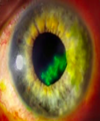STI & Eye Flashcards
(84 cards)
which STI is usually asymptomatic?
chlamydia
If a male has uretheral disachrge, what should you test for?
Gohonorrhea
Chlamydia (even though usually symptomatic, is more common than gonorrhea)
how often should one be screened for chlamydia?
yearly from aged 15-30 if they are sexually active
how does chlamydia normally present?
normally asymptomatic
discharge from penis / vagina
pain during urination
pain during sex
What are the complications of chlamydia in men and women?
Men
- Epididymitis & Epidydimo-Orchitis; which can lead to
- Infertility
- Reactive Arthritis (more common in men)
Women
- Pelvic inflammatory disease; which can lead to
- Infertility
- Ectopic pregnancy
- Persistent pelvic pain
Which STI can cause a reactive arthritis and in which sex?
chlamydia
reactive arthritis caused by chlamydia is more common in men than in women
What is the management of chlamydia?
Basics
Place & Person
Investigate & Confirm Diagnosis
- NAAT: specimen collected by -
- first pass urine
- endocervical swab
- cultured urethral discharge (if present)
Definitive Management
- 1g azithromycin po as a single dose
- Abstain from unprotected sexual intercourse for at least 7 days during and after treatment
- A notifiable disease - must notify DHS within 5 days of diagnosis
Follow-Up
- Contact tracing - advise to dicuss with sexual partners so they can be screened
- Re-test for chlamydia 3-4 months post treatment
how do you investigate for chlamydia?
NAAT
Method of collection:
- first pass urine
- endocervical swab
- urethral discharge (if present)
what is the typical presentation of gohnorrhea in men?
and in women?
Man with copious urethral discharge 2-10 days after unprotected sex (although chlamydia is still more common than gonorrhea, so still more likely to be chlamydia).
Women are usually asymptomatic or present with vague symptoms mimicking a UTI.
What is required to investigate for gonorrhea?
NAAT. Specimen collected by
- Urine (mid stream)
- Endocervical swab
- Rectal swab
- Throat swab
- Culture of discharge
Also investigate for chlamydia if you suspect gonorrhea!
what is the definitive management of chlamydia?
what is the definitive management of gonorrhea?
how are these managements potentially related?
Chlamydia = 1g azithromycin po, single dose
Gonorrhea = Ceftriaxone 250mg IM, single dose
If you are treating for gonorrhea, but you haven’t ruled out chlamydia - treat for chlamydia as well
What is the management of gonorrhea?
Investigate and Confirm Diagnosis
- NAAT, collected by:
- MSU
- Rectal swab
- Pharyngeal swab
- Endocervical swab
- Cultured discharge (if present)
Definitive Management
- IM 250mg ceftriaxone
- Advise to abstain for sex for 7 days?
Follow Up
- Notifiable disease - notify DHS within 5 days
- Contact tracing - treat sexual partners empirically
- Offer eductaion RE safe sexual practises
- Re-investiage 3-4 months after treatment, to ensure complete treatment
- ALSO TEST / TREAT CHLAMYDIA
Which STI is described as “the great imitator”?
Syphillus
What is the name of the microorganism which causes syphillus?
Treponema pallidum
How does primary syphillus present?
A single painless ulcer in the genital area (chancre)
What is the pathophysiological progression of syphillus?
Remember Syphillus happens in Stages
- Primary = Chancre
- Secondary = Secondary erruption on skin and mucous membranes (rash) +/- systemic symptoms
- Then long periods of latency
- Teritiary (10-30 years after infection) = late lesions of skin, bone, viscera, cardiovascular and central nervous systems (this is why it’s called the great mimcker)
How do you investigate for syphillus?
Syphillis EIA (blood test)
what is the definitife management of syphilllis?
early (
late (>2 years or unknown) = IM benzthine penicillin, weekly for 3 weeks
tertiatry syphillis (>2 years and with skin, bone, CVS or neurological involement) = IV benzylpenicillin
What is the overall management of syphillis?
Investigate and Confirm Diagnosis
- Seroloigcal test - Syphillis EIA
Definitive Management
- Early - IM benzathine penicillin, once off
- Late or unknown - IM benzathine penicillin, once per week for 3 weeks
- Tertiary - IV benzylpenicillin for 15 days
- Abstain from sex until completion of treatment
Follow-Up / Other
- Test for other STIs
- Notifiable disease - contact DHS
- Contact tracing
- Retest 3-4 months after completion of treatment
what is a common presentation of bacteral vaginosis?
asymptomatic
fishy-smelling vaginal discharge
dysuria
vaginal pruritis
pyspareunia
how do you diagnose bacterial vaginosis?
- Clincially
- presence of mucous dishachrge
- fishy smell
- clue cells on micrscopy (culture not required)
- Vaginal pH >4.5
What is the defitive management of bacterial vaginosis?
metronidazole (orally or vaginal gel)
OR clindamycin (orally or vaginal gel)
What is the pathophysiology of bacterial vaginosis?
- Reduction in the acid-producing normal flora of the vagina [Lactobacillus]
- Leads to growth of anaerobes and other fastidious microorganisms

















